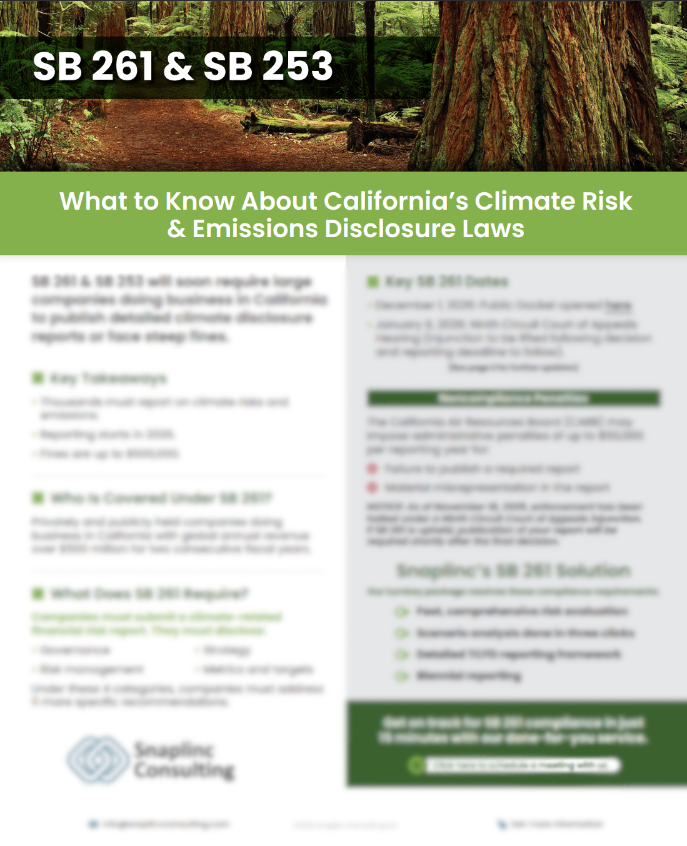
California SB 261: Strategic Climate Risk Disclosure for Business Compliance
New climate risk disclosure laws are coming fast and most companies aren't ready. Final regulations are expected by late 2025. The time to act is now.

California Senate Bill SB 261, known as the Climate-Related Financial Risk Act, mandates that large companies operating in California assess and publicly disclose how climate change may impact their financial health and operations. Enacted in October, 2023, it’s part of California’s push to enhance corporate transparency around climate claims. Affected companies face rigorous reporting requirements, with the first reports due in 2026.
Note: The Ninth Circuit Court of Appeals issued a temporary injunction in November, 2025 pausing enforcement of SB 261. The Court’s decision following a January 9, 2026 will determine whether SB 261 is upheld and when enforcement will begin.
Get a quick, easy-to-read snapshot of SB 261 requirements and deadlines in our downloadable bulletin.
-
Does SB 261 Apply to Your Business?
Here’s What It Requires:
► SB 261 requires companies doing business in California with $500M+ in global annual revenue for two consecutive fiscal years to file a climate-related financial risk report every two years.
► Reports must align with the TCFD framework: Governance, Strategy, Risk Management, and Metrics.
► Due Date: First report due January 1, 2026.
►Note: Enforcement is paused pending a decision from the Ninth Circuit Court of Appeals after a hearing on January 9, 2026.
Penalties: Up to $50,000 per year for noncompliance or misreporting.
**Insurance companies are exempt.
-
Why SB 261 Compliance Is Complex for Most Companies
SB 261 compliance isn’t a simple reporting task — it demands:
► Complex scenario modeling
► Multi-dimensional risk evaluations
► Deep understanding of the TCFD reporting framework
► Involvement from ESG, legal, finance, and risk teams
► Infrastructure to collect and disclose relevant data
**Most companies are not equipped to manage these internal demands. That’s where Snaplinc comes in.

In-House Compliance is Complicated. Simplify With Snaplinc Consulting.
Many companies underestimate the complexity of SB 261 — until it’s too late. This isn’t just an ESG report; it’s a regulatory disclosure governed by legal standards, financial risk language, and climate science. Tackling it with internal teams often leads to delays, reporting gaps, or costly missteps.
► Siloed Risk Ownership – Risk spans finance, ESG, ops, legal, and requires cross-functional coordination
► Lack of Climate Modeling Capabilities – Most teams haven’t done climate scenario analysis
► High Compliance Risk – Public disclosures with penalties and legal exposure if misrepresented
► No TCFD Experience and Time-Intensive Manual Work – Gaps in understanding and bandwidth to comply
According to our latest SB 261 briefing, scenario modeling and governance disclosures were flagged as the two biggest roadblocks for internal teams.
What You Get with Snaplinc’s Turnkey SB 261 Compliance Solution
Snaplinc delivers a complete, done-for-you solution that helps your company meet SB 261’s demanding disclosure requirements — quickly, accurately, and without overloading your internal teams.
Our turnkey service includes:
✔ A fully TCFD-aligned climate risk report
✔ Physical and transition risk identification across business units
✔ Scenario modeling under 1.5°C, 2°C, and 4°C regulatory pathways
✔ Governance and oversight documentation prepared for board-level review
✔ Submission-ready deliverables tailored to California’s CARB expectations
What to Know About SB 253
While SB 261 focuses on climate-related financial risks, SB 253 is California’s companion law that requires companies with over $1 billion in annual revenue to publicly report their greenhouse gas emissions including Scope 1, 2, and 3.
► Scope 1 & 2 reports are due starting 2026
► Scope 3 reporting begins 2027
We provide expert support for SB 253 compliance through robust emissions measurement and reporting, enabling companies to meet California’s disclosure requirements across Scope 1, 2, and 3 with precision and confidence.

Start Now. Stay Ahead of Regulation.
Want expert guidance? We’re ready to walk you through it — one step at a time.




